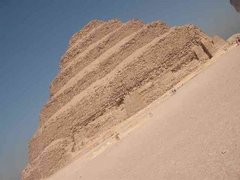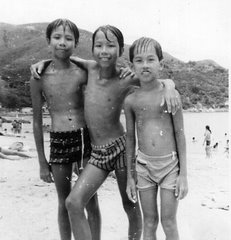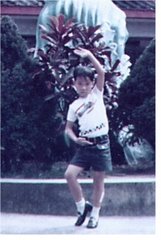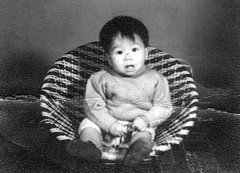


Nice to meet everyone in here. My name is Kenny and my family includes my wife, 3 cats, 13 fishes and etc.we are living in harmony.




 Dual Coding theory identified three types of processing: (1) representational, the direct activation of verbal or non-verbal representations, (2) referential, the activation of the verbal system by the nonverbal system or vice-versa, and (3) associative processing, the activation of representations within the same verbal or nonverbal system. A given task may require any or all of the three kinds of processing.
Dual Coding theory identified three types of processing: (1) representational, the direct activation of verbal or non-verbal representations, (2) referential, the activation of the verbal system by the nonverbal system or vice-versa, and (3) associative processing, the activation of representations within the same verbal or nonverbal system. A given task may require any or all of the three kinds of processing. 
 Interesting photo from Egypt, however, what type of theme or organizational plan to show this picure? Creating specific pages for collection of photos or something creative presentation?
Interesting photo from Egypt, however, what type of theme or organizational plan to show this picure? Creating specific pages for collection of photos or something creative presentation?
 Finally, I cut down the image for part of my illustration combined with other diagrams from internet, for example, Wikepedia and other documents. All mixed with each other, it could enhance the effectiveness of representation vividly and colorfully. And now I shared with you and hope to have comments on it. Please click on the below picture:
Finally, I cut down the image for part of my illustration combined with other diagrams from internet, for example, Wikepedia and other documents. All mixed with each other, it could enhance the effectiveness of representation vividly and colorfully. And now I shared with you and hope to have comments on it. Please click on the below picture:  http://iln.cite.hku.hk/com/1374/users/wctang/Task2.ppt
http://iln.cite.hku.hk/com/1374/users/wctang/Task2.ppt I just learnt that "visuals” invented to communicate complex ideas from Lester(2000). Pictures could be a powerful instrument so that viewers captured the concepts easily, at least it enhanced the effectiness on initial impression. While I attempted to fill in the colors on my drawing script, it stimulated me to think about how people to reason the information, especially for those who youngsters, grown up with abundant information of multimedia, could catch up knowledge easily by the mean of images. Visualizing meanings from visual formate, it could assist to reason the concise. Therefore, I utilized the space and partitions to fills in colors and marked down keywords to illustrate the concept. The above key points tell me how important of understanding visual language. In the process of drafting, drawing and noting down the keywords, I could clarity how I learnt from the concepts profoundly, and it could encourage me to use more presentative formats, for example symbols, icons, diagrams, charts, mindmaps , even diagram with 3-dimensions. By Daniel's handouts, I hope to leant more methods to enhance the interactive outcomes and then viewers could capture my messages or information that I was eager to tell them about.
I just learnt that "visuals” invented to communicate complex ideas from Lester(2000). Pictures could be a powerful instrument so that viewers captured the concepts easily, at least it enhanced the effectiness on initial impression. While I attempted to fill in the colors on my drawing script, it stimulated me to think about how people to reason the information, especially for those who youngsters, grown up with abundant information of multimedia, could catch up knowledge easily by the mean of images. Visualizing meanings from visual formate, it could assist to reason the concise. Therefore, I utilized the space and partitions to fills in colors and marked down keywords to illustrate the concept. The above key points tell me how important of understanding visual language. In the process of drafting, drawing and noting down the keywords, I could clarity how I learnt from the concepts profoundly, and it could encourage me to use more presentative formats, for example symbols, icons, diagrams, charts, mindmaps , even diagram with 3-dimensions. By Daniel's handouts, I hope to leant more methods to enhance the interactive outcomes and then viewers could capture my messages or information that I was eager to tell them about. Upon the requirement of assignment, I decided to meet the purpose of illustration and look closely at an easy-captured ways for the people to get the concept. This often included keywords and graphic illustration by allocating the partitions to make people understand branches of concepts. For me, visual illustration was an useful instrument that helped me to clarify the concise and it would attract people to share with my ideas, and reason the messages that I wanted to deliver. In this assignment, I used a hand-made picture to illustrate part of the content and it could draw people’s attentions to get the impression firstly. However, I also collected other references for presenation of my ideas, and eventually I decided to use mixed approach for illustration with other ready-made diagrams. Sometimes, it could save my time to accomplish the residual concepts and highlighed all information with interactive enrichment
Upon the requirement of assignment, I decided to meet the purpose of illustration and look closely at an easy-captured ways for the people to get the concept. This often included keywords and graphic illustration by allocating the partitions to make people understand branches of concepts. For me, visual illustration was an useful instrument that helped me to clarify the concise and it would attract people to share with my ideas, and reason the messages that I wanted to deliver. In this assignment, I used a hand-made picture to illustrate part of the content and it could draw people’s attentions to get the impression firstly. However, I also collected other references for presenation of my ideas, and eventually I decided to use mixed approach for illustration with other ready-made diagrams. Sometimes, it could save my time to accomplish the residual concepts and highlighed all information with interactive enrichment 
Initially, I planed to make the representation by noting down which keywords should be in cluded and illustrated within a confined area for one page only. I drafted out the ideas by the method of mind-mapping, I could clarify my ideas with respect to the keywords or concept assigned by the topic. One by one, I used the lines to associate with the related concept that included several keywords to demonstrate the contents. It was also the time for me to think about the method or style of presentation. I would consider choosing either referring other diagrams or pictures by ready-made format or hand made by myself.







